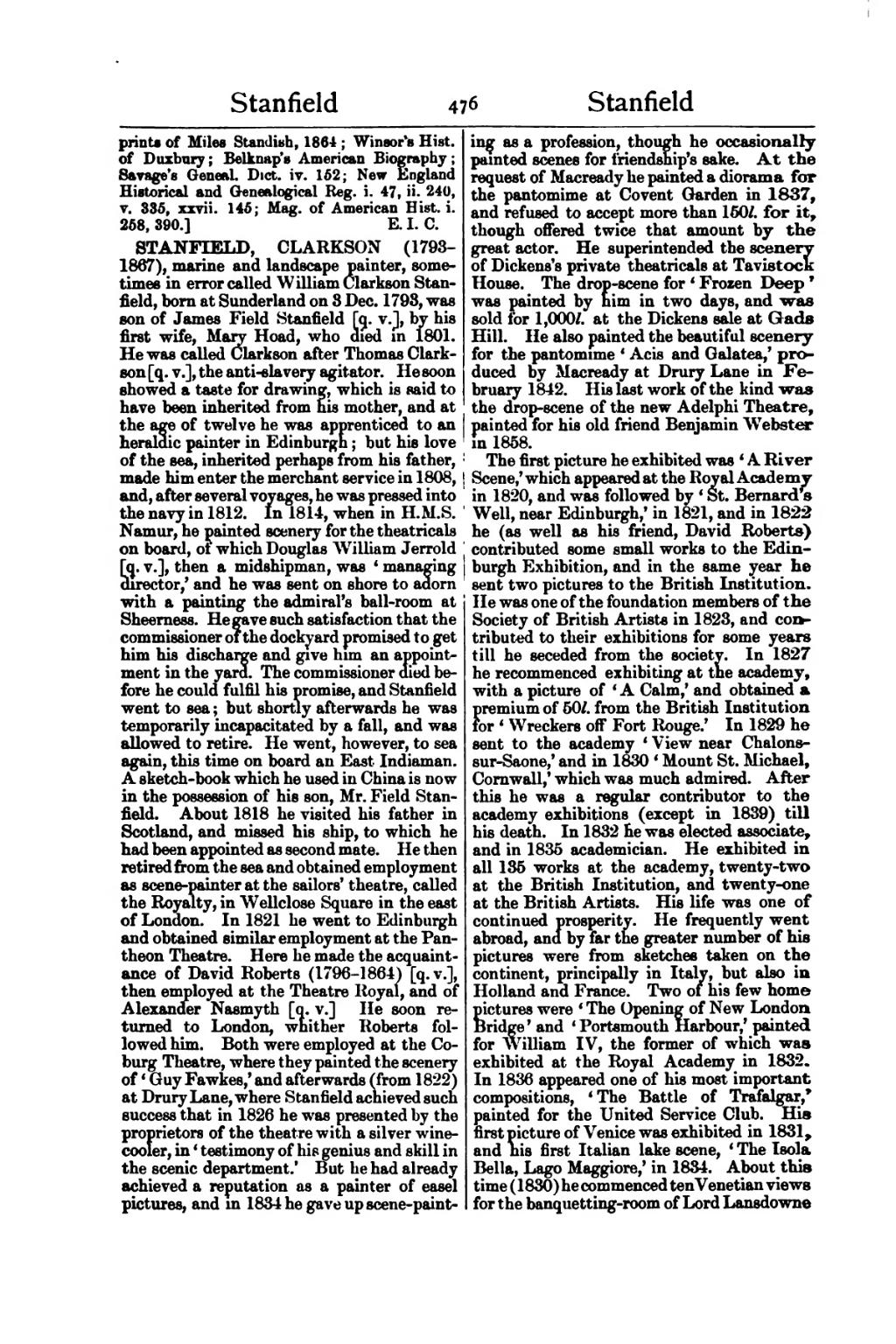STANFIELD, CLARKSON (1793–1867), marine and landscape painter, sometimes in error called William Clarkson Stanfield, born at Sunderland on 3 Dec. 1793, was son of James Field Stanfield [q. v.], by his first wife, Mary Hoad, who died in 1801. He was called Clarkson after Thomas Clarkson [q. v.], the anti-slavery agitator. He soon showed a taste for drawing, which is said to have been inherited from his mother, and at the age of twelve he was apprenticed to an heraldic painter in Edinburgh; but his love of the sea, inherited perhaps from his father, made him enter the merchant service in 1808, and, after several voyages, he was pressed into the navy in 1812. In 1814, when in H.M.S. Namur, he painted scenery for the theatricals on board, of which Douglas William Jerrold [q. v.], then a midshipman, was ‘managing director,’ and he was sent on shore to adorn with a painting the admiral's ball-room at Sheerness. He gave such satisfaction that the commissioner of the dockyard promised to get him his discharge and give him an appointment in the yard. The commissioner died before he could fulfil his promise, and Stanfield went to sea; but shortly afterwards he was temporarily incapacitated by a fall, and was allowed to retire. He went, however, to sea again, this time on board an East Indiaman. A sketch-book which he used in China is now in the possession of his son, Mr. Field Stanfield. About 1818 he visited his father in Scotland, and missed his ship, to which he had been appointed as second mate. He then retired from the sea and obtained employment as scene-painter at the sailors' theatre, called the Royalty, in Wellclose Square in the east of London. In 1821 he went to Edinburgh and obtained similar employment at the Pantheon Theatre. Here he made the acquaintance of David Roberts (1796–1864) [q. v.], then employed at the Theatre Royal, and of Alexander Nasmyth [q. v.] He soon returned to London, whither Roberts followed him. Both were employed at the Coburg Theatre, where they painted the scenery of ‘Guy Fawkes,’ and afterwards (from 1822) at Drury Lane, where Stanfield achieved such success that in 1826 he was presented by the proprietors of the theatre with a silver wine-cooler, in ‘testimony of his genius and skill in the scenic department.’ But he had already achieved a reputation as a painter of easel pictures, and in 1834 he gave up scene-painting as a profession, though he occasionally painted scenes for friendship's sake. At the request of Macready he painted a diorama for the pantomime at Covent Garden in 1837, and refused to accept more than 150l. for it, though offered twice that amount by the great actor. He superintended the scenery of Dickens's private theatricals at Tavistock House. The drop-scene for ‘Frozen Deep’ was painted by him in two days, and was sold for 1,000l. at the Dickens sale at Gads Hill. He also painted the beautiful scenery for the pantomime ‘Acis and Galatea,’ produced by Macready at Drury Lane in February 1842. His last work of the kind was the drop-scene of the new Adelphi Theatre, painted for his old friend Benjamin Webster in 1858.
The first picture he exhibited was ‘A River Scene,’ which appeared at the Royal Academy in 1820, and was followed by ‘St. Bernard's Well, near Edinburgh,’ in 1821, and in 1822 he (as well as his friend, David Roberts) contributed some small works to the Edinburgh Exhibition, and in the same year he sent two pictures to the British Institution. He was one of the foundation members of the Society of British Artists in 1823, and contributed to their exhibitions for some years till he seceded from the society. In 1827 he recommenced exhibiting at the academy, with a picture of ‘A Calm,’ and obtained a premium of 50l. from the British Institution for ‘Wreckers off Fort Rouge.’ In 1829 he sent to the academy ‘View near Chalons-sur-Saone,’ and in 1830 ‘Mount St. Michael, Cornwall,’ which was much admired. After this he was a regular contributor to the academy exhibitions (except in 1839) till his death. In 1832 he was elected associate, and in 1835 academician. He exhibited in all 135 works at the academy, twenty-two at the British Institution, and twenty-one at the British Artists. His life was one of continued prosperity. He frequently went abroad, and by far the greater number of his pictures were from sketches taken on the continent, principally in Italy, but also in Holland and France. Two of his few home pictures were ‘The Opening of New London Bridge’ and ‘Portsmouth Harbour,’ painted for William IV, the former of which was exhibited at the Royal Academy in 1832. In 1836 appeared one of his most important compositions, ‘The Battle of Trafalgar,’ painted for the United Service Club. His first picture of Venice was exhibited in 1831, and his first Italian lake scene, ‘The Isola Bella, Lago Maggiore,’ in 1834. About this time (1830) he commenced ten Venetian views for the banquetting-room of Lord Lansdowne
